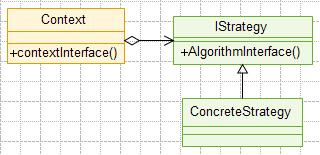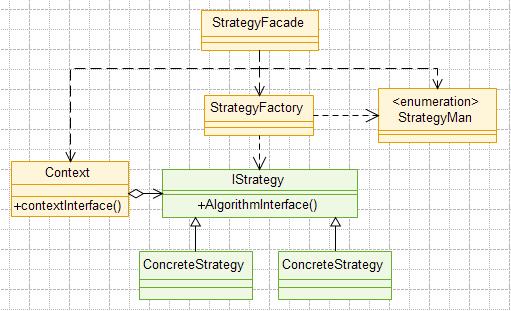策略模式
Posted best.lei
tags:
篇首语:本文由小常识网(cha138.com)小编为大家整理,主要介绍了策略模式相关的知识,希望对你有一定的参考价值。
| 策略模式 |
- 策略模式:也叫作政策模式,定义一组算法,将每个算法都封装起来,并且使他们之间可以互换
- 策略模式的使用就是面向对象的继承和多态机制,其通用类图如下:

-
- Context封装角色,也叫作上下文角色,屏蔽高层模块对策略、算法的直接访问,封装可能的变化。
- Istrategy抽象策略角色,策略算法家族的抽象,通常为接口定义每个算法必须具有的方法和属性。
- ConcreteStrategy具体策略角色,实现抽象策略中的操作该类含有具体的算法。
通用类图的源码如下:
-
-
public interface IStrategy { //定义具体策略必须具有的方法 public void doSomething(); } public class ConcreteStrategy1 implements IStrategy{ public void doSomething(){ System.out.println("this is a concreteStrategy"); } } public class ConcreteStrategy2 implements IStrategy{ @Override public void doSomething() { // TODO Auto-generated method stub System.out.println("This is concreteStrategy2"); } } public class Context { private IStrategy strategy = null; public Context(IStrategy strategy){ this.strategy = strategy; } public void doSomething(){ this.strategy.doSomething(); } } public class Client { /** * @param args */ public static void main(String[] args) { // TODO Auto-generated method stub Context text = new Context(new ConcreteStrategy2()); text.doSomething(); text = new Context(new ConcreteStrategy1()); text.doSomething(); } }
-
| 策略模式的优缺点 |
- 策略模式的优点
- 算法可以自由的切换,通过实现抽象策略,通过封装角色对其封装,保证对外提供“可自由切换”的策略。
- 避免使用多重条件判断,如果有多重策略,那么每个策略只需实现自己的方法,至于采用何种策略,可以通过其他模块决定。
- 扩展性良好,可以在现有的系统中任意的加入新的策略,只需继承IStrategy接口,符合OCP原则。
- 策略模式的缺点
- 策略类数量增多,每个策略都是一个类,复用的可能性很小,类数量增多
- 所有的策略都需要对外暴露,上层模块必须知道有哪些策略,然后才能知道采用哪种策略,可以通过使用工厂方法模式、代理模式和享元模式修正。
| 策略模式的扩展(工厂方法模式+策略模式) |
首先策略枚举StrategyMan,负责对具体策略的映射,然后建立一个简单的工厂,根据策略管理类的枚举项创建一个策略对象,简单而实用,策略模式的缺陷得到了弥补。其通用类图如下:

-
 View Code
View Codepublic enum StrategyMan { Strategy1("com.strategy.ConcreteStrategy1"), Strategy2("com.strategy.ConcreteStrategy2"); String value = ""; private StrategyMan(String value){ this.value = value; } public String getValue(){ return this.value; } } public class StrategyFactory { public static IStrategy getStrategy(StrategyMan strategyman){ IStrategy strategy = null; try { strategy = (IStrategy) Class.forName(strategyman.getValue()).newInstance(); } catch (InstantiationException | IllegalAccessException | ClassNotFoundException e) { // TODO Auto-generated catch block e.printStackTrace(); } return strategy; } } public class StrategyFacade { public void doSomething(String str){ StrategyMan sMan = null; if(str.equalsIgnoreCase("Strategy1")){ sMan = StrategyMan.Strategy1; }else if(str.equalsIgnoreCase("Strategy2")){ sMan = StrategyMan.Strategy2; } IStrategy strategy = StrategyFactory.getStrategy(sMan); Context context = new Context(strategy); context.doSomething(); } } public class Client { /** * @param args */ public static void main(String[] args) { // TODO Auto-generated method stub StrategyFacade sFacade = new StrategyFacade(); sFacade.doSomething("Strategy1"); } }
以上是关于策略模式的主要内容,如果未能解决你的问题,请参考以下文章
